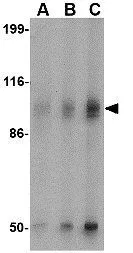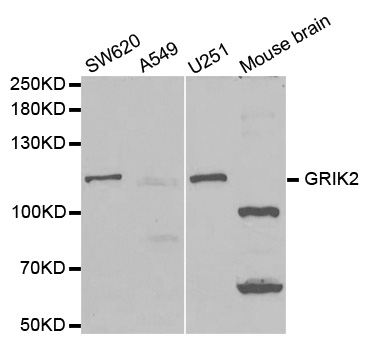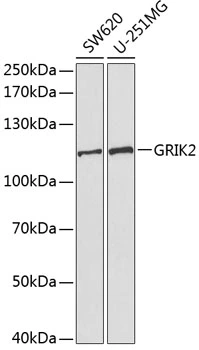
WB analysis of human brain tissue lysate using GTX31328 GluR6 antibody. Working concentration : (A) 0.5 and (B) 1 microg/ml
GluR6 antibody
GTX31328
ApplicationsWestern Blot, ELISA
Product group Antibodies
TargetGRIK2
Overview
- SupplierGeneTex
- Product NameGluR6 antibody
- Delivery Days Customer9
- Application Supplier NoteWB: 0.5 - 1 microg/mL. *Optimal dilutions/concentrations should be determined by the researcher.Not tested in other applications.
- ApplicationsWestern Blot, ELISA
- CertificationResearch Use Only
- ClonalityPolyclonal
- Concentration1 mg/ml
- ConjugateUnconjugated
- Gene ID2898
- Target nameGRIK2
- Target descriptionglutamate ionotropic receptor kainate type subunit 2
- Target synonymsEAA4, GLR6, GLUK6, GLUR6, GluK2, MRT6, NEDLAS, glutamate receptor ionotropic, kainate 2, GluK2(alt_5'UTR), bA487F5.1, excitatory amino acid receptor 4, gluR-6, glutamate receptor 6, glutamate receptor form A, glutamate receptor form B, glutamate receptor form C, glutamate receptor form D, glutamate receptor form E, putative NMDtranscript(cassette_171nt)
- HostRabbit
- IsotypeIgG
- Protein IDQ13002
- Protein NameGlutamate receptor ionotropic, kainate 2
- Scientific DescriptionGlutamate receptors are the predominant excitatory neurotransmitter receptors in the mammalian brain and are activated in a variety of normal neurophysiologic processes. This gene product belongs to the kainate family of glutamate receptors, which are composed of four subunits and function as ligand-activated ion channels. The subunit encoded by this gene is subject to RNA editing at multiple sites within the first and second transmembrane domains, which is thought to alter the structure and function of the receptor complex. Alternatively spliced transcript variants encoding different isoforms have also been described for this gene. Mutations in this gene have been associated with autosomal recessive mental retardation. [provided by RefSeq, Jul 2008]
- Storage Instruction-20°C or -80°C,2°C to 8°C
- UNSPSC12352203





